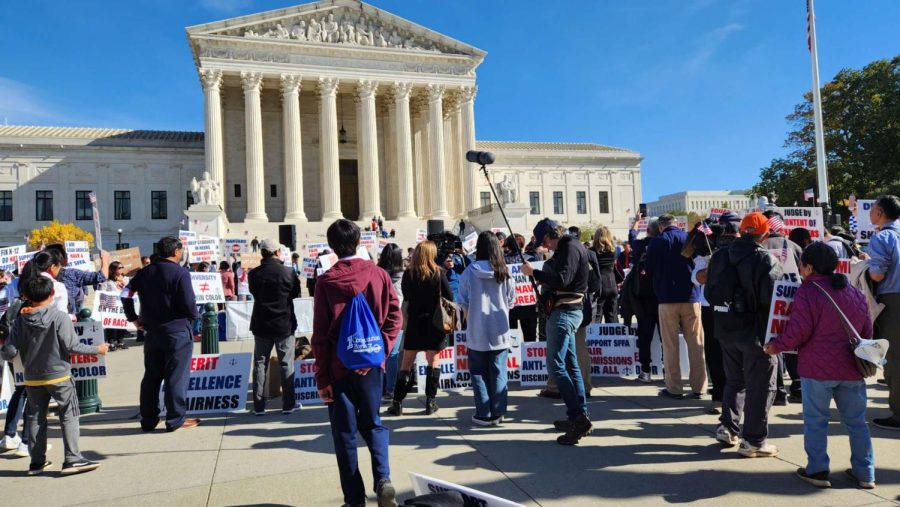Controversy sparks over new affirmative action case
Protestors stand outside the Supreme Court on Oct. 30, a day before the beginning of arguments regarding the status of affirmative action at U.S. colleges.
March 21, 2023
Racism is deeply ingrained into this country’s history, and the decades of systematic oppression cannot be easily reversed. Affirmative action was originally intended to reduce discrimination in the employment process and today is well-known to be used for universities to expose their student body to a diverse combination of people they will interact with in the future. A large percentage of students at WCHS are Asian American (specifically 30.6 percent). At WCHS, the competitive and well-funded environment has produced highly ambitious students who have an understanding of the standards they must meet in the college process.
The Supreme Court has been reviewing affirmative action regarding Harvard University and the University of North Carolina, Chapel Hill (UNC). As a state school, UNC’s affirmative action program is being investigated as it is suspected to violate the 14th Amendment’s equal protection clause. Additionally, although Harvard is a private institution, they receive federal funding and therefore must abide by federal anti-discrimination laws. To strengthen their argument, conservatives against affirmative action are speaking for Asian Americans to convince others that it does not provide equal opportunity.
“[Non-POC (people of color)] are speaking from a place of privilege and speaking for groups they are not a part of, which is completely counterintuitive,” WCHS junior Anjali Tatvarthy said. “ There are a myriad of struggles that Asian Americans endure, despite being viewed as more privileged, that white people never had to face.”
Although still a minority, Asian Americans have begun to be considered equal to white Americans due to their academic success. In 2021, the University of Maryland grouped people of color minus Asian Americans into one category while grouping Asians and white Americans into another. The two races have vastly different experiences, as being Asian American exposes this demographic to specific standards created by stereotypes.
“Asians have always been considered the model minority,” WCHS AP Environmental Science teacher Mira Chung said. “When I was in school, I struggled in math and since I was Asian, there would be microaggressions about why I wasn’t good at math. I wasn’t very focused on [by teachers] because as an Asian child, if I didn’t do well in school, it wasn’t the teacher’s fault; it was always my fault.”
The generalization of the Asian American demographic as smarter or more educated has exposed them to harmful standards that they are expected to uphold. Consequently, their image as the prosperous minority was formed.
“The case is based on the model minority myth, which is the idea that all Asian Americans are a “successful minority” in the US,” WCHS junior Allison Zhang said. “This not only creates a damaging mindset by pitting minorities against each other, but it also groups all Asian Americans together into a stereotype that is simply not true. Asian Americans are made up of many different communities, and viewing all of these communities as the same erases their unique identities.”
The idea of Asian Americans being the model minority is harmful to the diversity of the demographic itself. Rather than looking at Asian Americans as a whole, people spoke for Asian Americans specifically against affirmative action.
“The case cherry-picks individuals from the Asian American community who disagree with affirmative action when in reality, many Asian Americans support and stand to benefit from affirmative action,” Zhang said. “I think that the main reason why they decided to use Asian Americans in their case is to bring that minority “voice” into their argument even though their argument can’t be truly representative of all Asian Americans as they are ignoring the entire picture.”
Even though it is believed by many that a majority of Asian Americans are against affirmative action, according to AAPI Data, 69% of Asian Americans are in favor of affirmative action. Although many individuals have understood why colleges feel affirmative action is necessary, they believe it was the main factor that confirmed their acceptance or rejection.
“I think that such people are quick to assume that when a white or Asian American applicant is denied from a school, it is automatically due to affirmative action,” WCHS junior Mira Wedam said. “Acceptance into a college is determined by a multitude of factors, so it is ignorant to assume that affirmative action is the only factor.”
The college admission process is complex and a variety of components decide whether or not a student receives an acceptance or rejection to a college. These reasons include grades, socioeconomic status, extracurriculars, essays, interest, comparison to class, and much more. Each college has different standards or different application parts that they weigh differently.
“[Students must realize that] you are making the choice as a kid to go to their college [and] fall into their choice,” Chung said. “If you fail a certain criteria they want you to meet, they do not care. There’s going to be someone else to fill in your shoes. I think that whatever the outcome [of the UNC and Harvard case] is, there will be a long battle to [prove affirmative action to be constitutional or not]. But I think it is really great that these types of issues are coming forward and having the willingness to talk about them.”
In early November, multiple student-led Asian American groups rallied for affirmative action in front of the Supreme Court. These students see the benefit of the diversity their universities do not want it taken away.
“I think it’s good that people are using their voice to be heard,” Zhang said. “They are finally taking a stand for what they believe instead of letting this untrue narrative perpetuate. It’s a good way to start more conversation about this topic and it especially brings to attention that not all Asian Americans are against affirmative action.”
Although students are not speaking out to voice their true opinions, damage has already been done and a false narrative generalizing what all Asians believe has been spread.
“This case will negatively affect the view toward Asian Americans because it plays into untrue stereotypes that seek to generalize an extremely diverse demographic,” Zhang said. “It creates a tension between Asian Americans and other minorities, which only further isolates the Asian community when in actuality, we should all be empowering each other and advocating for a more just college admissions process.”
By stating that Asian Americans are entirely against affirmative action, it brought upon a further divide between minority groups. Yet, the case itself could bring about a new view toward affirmative action.
“I think [this case] will change the way I view [affirmative action] because it will highlight the flaws in its structure,” Tatvarthy said. “This is already a struggle in America so further increasing tensions between people of color would only increase division. Pinning people of color groups against each other leads to the advancement of privileged people, which is what the current structure of affirmative action does. With improvement, it could be a significant advantage to every racial group, but by trying to cleave marginalized groups who need to stick together, it may only end in destruction.”



